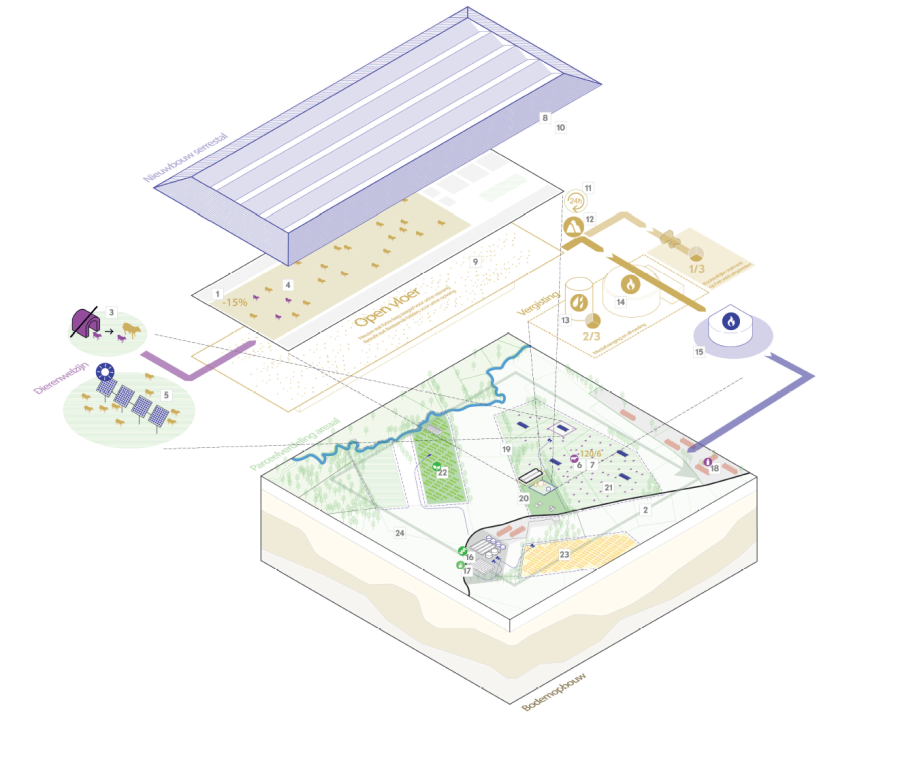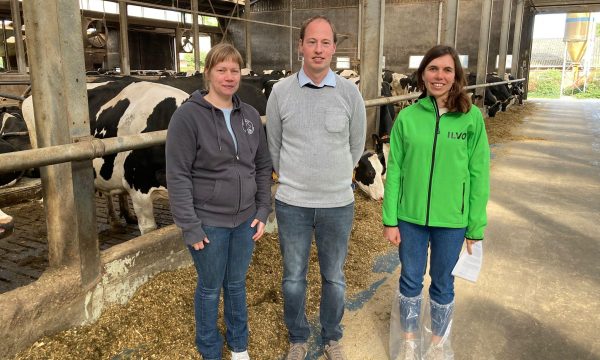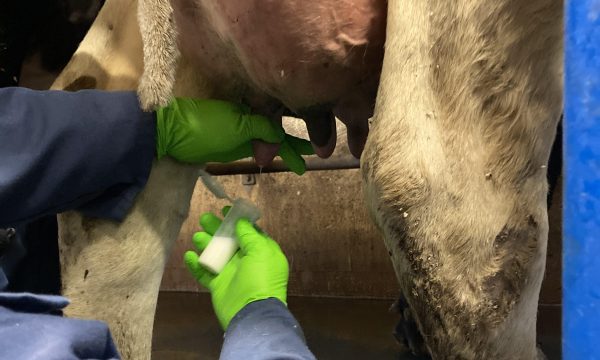Press release Dairy wood farmer, dairy residual-flow farmer... ILVO in search of future-proof business concepts in the dairy sector

How can individual dairy farms secure their future in a changing context? Commissioned by the Flemish Land Agency, ILVO researchers have developed ten schools of thought around this question. Two scenarios were fully developed and calculated in terms of economic, ecological, spatial and social impact. They both start from the hypothesis that a dairy farm would keep 15% fewer cows and that other income-producing activities would be developed with the freed up space and labor.
In the dairy wood farmer concept, the freed up space and labor would shift to agroforestry, which can yield financially attractive figures. Another concept is the dairy residual-flow farmer. That creates added value from residual flows such as manure, urine and ammonia emissions, by turning them into fuel, electricity or renure, and participating in the protein transition. Feasible, but requiring hefty initial investments, according to the cost-benefit picture. The research project 'Innovative Dairy Farming Concepts' will be presented on 7 June 2024 in Ghent, during an interactive seminar with the sector and stakeholders.
Expected future - with challenges
Concrete challenges can be serious in the near future of Flemish dairy farming. In terms of access to land, the area available for food production is expected to decrease further over the next 20 years because of a continuing pattern of spatial fragmentation in Flanders and high competition for land.
With further climate change, Flemish policy is pushing dairy farming towards a more climate-robust production system with a reduction in greenhouse gas emissions over the next 20 years. Livestock farmers will also have to be climate-adaptive to remain profitable. Animal welfare will receive increasing attention. And the protein transition trend will see policies promoting increased production and consumption of non-animal proteins. Ongoing biodiversity loss makes it likely that policy objectives in that area will tighten. For agriculture, that could mean more biodiversity conservation efforts and practices like functional agrobiodiversity and "green" dairying with more quality labels. Finally, Europe is likely to focus more on food security and internal food production, so-called (re)regionalization within the EU. This includes reducing our dependence on imported soy.
Moving forward together with business as usual?
In this research project, ILVO agricultural economists and dairy specialists first explored the future of the sector in the case of a 'Business-As-Usual' scenario, in which all dairy farms continue to follow the same specialized path as in 2023. 'In that scenario, we see positive evolutions but also risks. On the one hand, a lot can certainly be expected from sensor technology and genetics in the near future, which will increase milk productivity per cow, for instance, which has already risen sharply over the past decade. The ongoing increase in scale continues, with fewer farms in total (not everyone has a successor) and more cows per farm. 'The dynamics of large new investments remains,' says Bart Sonck, head of animal research at ILVO. 'But at the same time it is almost certain that the dairy herd as a whole will not increase further, perhaps even decrease, because of the high environmental and climate challenges and the continuing volatile price development on the world market (economic uncertainties put pressure on profitability). A Business-As-Usual (BAU) logic in the future is not the most advantageous option for a number of Flemish livestock farmers. There is therefore a need to think about innovative dairy farming concepts, in which the farmer remains profitable and socially relevant, and in which income is generated from other activities besides milk. The researchers are convinced that sustainable, people- and animal-friendly dairy farming is possible in Flanders, and that dairy farming - as one of the largest users of space in Flanders - plays an indispensable role.
Towards alternative, innovative dairy farming concepts: the methodology
The Innovative Dairy Farming Concepts project team consisted of researchers from ILVO and Wageningen Livestock Research (WUR), spatial planners, an expert from VCM and two dairy farmers. They had a stated ambition to create concepts that were systemically promising; these had to be sustainable ecologically, economically, socially and spatially. The researchers worked with the hypothesis of a 15% animal reduction (in order to achieve the proposed emission reduction) and looked at the workability of a series of alternative infills for the freed-up land and labor. Dairy farmers, specialists from the 'new' incoming sectors, and especially economists and ecologists were involved. Anna Verhoeve, ILVO socio-economic and spatial researcher: 'ILVO built several digital decision tools in the past, such as the 'Routeplanner' for Dairy Cattle, Klimrek and Agroforestry Feasibility. Farmers can enter their individual farm figures in these tools and calculate from a few criteria which possible investments or farm choices, ration compositions, etc. lead to which financial result. 'In the research project Innovative Dairy Farming Concepts, these tools were used for the first time to assess scenarios for a longer future,' the Dairy Routeplanner tool has been given a more comprehensive, user-friendly new version, partly due to this use. Routeplanner Dairy Cattle 2.0 will be available to the whole Flemish dairy sector by mid-2025.
Dairy wood farmer: promising idea
The Dairy Wood Farmer applies agroforestry on the dairy farm by planting trees and shrubs that provide nuts, fruit and wood (poplar and willow), as well as additional biodiversity. Walnut or optional semi-stemmed fruit trees will be planted on the permanent pastures (scattered) and on the arable plots (in strips). The grazing pastures and the cow paths to them will be lined with forage trees from which the animals can eat directly for their fiber and protein intake, and for minerals and tannins. An additional crop, namely protein-rich field beans, is added in the rotation of maize and grass. These beans, when toasted for more rumen resistant protein can replace soya as a protein component in concentrate feed. Green material from pruning covers part of the maintenance costs as bedding material. The barn now gives more space per cow, bull calves stay longer and are therefore sold at a higher price.
... with a favorable cost-benefit
The simulation (calculated on a reference scenario with 100 dairy cows on an area of 55.1 hectares) shows that switching to agroforestry and own protein production can be a promising and profitable strategy for dairy farms. An investment in walnut cultivation proves profitable with a payback period of 11 to 16 years, depending on whether or not labor costs are included.
In addition to the economic benefits, there are unspecified ecological benefits, such as natural pest control, biodiversity conservation and carbon sequestration. Greenhouse gas emissions fall 22%, apart from the additional mitigation effect of above-ground and underground carbon storage. Water resources are depleted less, falling from -57% to -43%. Fossil resource use falls by 30%. There is 20% less eutrophication of the freshwater environment (P), 20% less acidification, and 14% less land use, all due to livestock reduction.
Dairy residual-flow farmer: strong assets but ...
This concept spends its 15% of freed-up resources on upgrading residual flows to achieve better closed cycles in food production, with the soil and the cow as essential cycle links. In a new-build situation, the barn is a demountable, low-cost, lightweight construction, according to the greenhouse concept, so that in changing times it can also be switched to vegetable production. There is a system of separate urine collection in manure basements, to be used in a stripping-scrubbing plant that eventually delivers ammonium salts (-sulphate or -nitrate), a type of RENURE fertilizer. In the eating and walking area, the solids are fermented in an on-farm biogas fermenter. The biogas produced is used primarily for mechanization on the farmyard. The remainder is converted to electricity and heat on site in a cogeneration plant (CHP). The lying area for the dairy cows (and lactating calves) is concrete-free. A thick absorbent layer of sawdust and litter decompose into carbon-rich farmyard manure. After grinding, this can go into the digester, or directly (once a year) onto the field.
Additional quantities of protein crops such as oats and soy are grown to produce plant-based dairy alternatives. The residual flows are given to the cows as feed.
... with pricey cost-benefit results
The simulation (calculated on a reference farm with 200 cows on an area of 110.2 hectares) shows that the cultivation of oats as feedstock for plant-based milk alternatives gives an increased gross balance, i.e. revenues from oat sales partly offset the higher cultivation costs. The investment in on-farm biogas production with an electrical capacity of 40 kWh becomes profitable, mainly due to the co-digestion of carbon-rich ensiled roadside grass, which increases biogas yield. The payback period of the investment is about 9 years. Financing can be challenging, however. The ecological pass-through could not yet be done correctly because the calculation factors for the new technologies such as stripping-scrubbing and RENURE field application are currently missing.
Decision and future
Innovative Dairy Farming Concepts offers starting points for future-oriented dairy farming in Flanders. The researchers and stakeholders involved have already concretized the possible roles of the various actors, as a possible basis for a real plan of action.
For the authorities, there are at least four: /Make sure there is room in the forest strategy /Make sure that (in a European context) mineral concentrates from animal manure (RENURE) are recognised as a substitute for artificial fertilisers /Create incentives to replace diesel for mechanisation with self-produced biogas /Make sure there is a revenue model around carbon storage in the soil.
Two questions are for the farming organizations: /Help (together with other actors) to long-term experiments with the new practices in these concepts /Support long-term learning working groups to lower the adoption threshold for these practices.
Chain partners can play a role in: /R&D and a price guarantee system for the forerunners of producing local protein crops for plant humane consumption /Share knowledge and expertise with dairy farmers around protein crop cultivation and processing.
Civil society organizations (NGOs, nature associations, etc.), agricultural and horticultural education and scientists also have work to do in this sustainability transition. To farmers, Innovative Dairy Farming Concepts says: Dare to think out-of-the-box and take leaps and bounds.
Seminar: practical info
The results of Innovative Dairy Farming Concepts will be presented to stakeholders (in Dutch) from policy and the agricultural midfield on 7 June 2024 in Ghent VAC Ghent | Virginie Loveling building, room 04.02 - Leo Baekeland. The aim is to then organize round-table discussions with the attendees on what the results mean in practice, and how the sector can use them.


